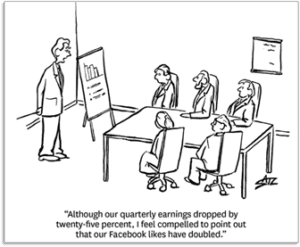The Big Story: CMOs Can’t Defend What They Can’t Define – Adweek
“Plenty of CMOs, it seems, have trouble defending their department because they can’t demonstrate how their team generates revenue.”
How do you feel about being average?
By Abby McNeil
4-minute read
When 50 chief marketing officers of various US companies were recently asked which department in their organization would be the first to see their budget shrunk in a downturn, two-thirds said “marketing.”
That’s troubling enough. When asked “why?”
“ROI on marketing can be hard to define,” 70 percent said.
Seems even in marketing we have a failure to communicate.
No doubt, healthcare organizations are reeling from significant financial pressure and leadership teams are taking a surgical approach to budgets.
But now is not the time for providers to disappear from the marketing landscape. With a proliferation of competitors on the prowl, visibility is more important than ever. Plus, research shows companies that maintain or increase spending on marketing and advertising through tough financial moments come out stronger than those who cut.
Making the case for holding the line on marketing budgets is tough, though the article does point out that a majority of CMOs aren’t necessarily expecting smaller budgets – just that they’d be first if things go sideways.
Uncertainty about the marketing budget appears on both sides of the equation. On the CEO side, consider a 2022 Boathouse survey that asked CEOs to grade their CMOs. The CEOS handed out more Cs than As on overall performance. And only 16 percent gave their CMO an A on “ability to drive company growth.” Even more concerning? Only 49 percent said, “The CMO is on my side, I trust them.”
Overall, pretty “meh.” So, with an average report card from the CEO and worry that marketing would be first in line if cuts happen, what is a savvy marketing officer to do to build trust, protect the budget and advance the organization?

Harvard Business Review, September 2013. Cartoon by Crowden Satz, HBR visual library. ©HBR.org
Let’s be real. You can’t fix a practice’s financial issues with more marketing if the actual issue is that the physician will only schedule in-office appointments every Tuesday when there’s a full moon. Throwing ad dollars at driving patient volume to a service line that’s not easily accessible would be the best marketing investment your competitor didn’t have to make.
Imagine it: Patient sees your ad, decides they need the service, calls to make an appointment, finds out it’ll be three months, hangs up, calls your competitor, gets an appointment in two weeks, has a great experience and tells her friends.
Better to figure these things out in collaboration with other leaders before you even start developing a campaign. Because you likely won’t have the time, money or opportunity to fix them after.
Know who’s the hero of the story. (It’s not you.) Invest in the interpersonal and professional work required to develop a relationship with your leaders. That’ll help everyone understand everyone else’s language and how the numbers you’re each responsible for play off one another other.
For marketers, this work will give you a sophisticated understanding of what your leadership team values. Then you can demonstrate how marketing is delivering in those areas and helping them achieve their goals for the organization.
A bonus: This effort increases your political capital. You’re going to be hard-pressed to make the data UNDENIABLE or un-spinnable. So, being smart about relationships allows you to match the data to what your leaders need and how they think about things.
To put it bluntly: If they don’t know you, don’t trust you…they aren’t going to trust your data.
Speak to the needs of today and tomorrow. It’s easy for leadership to get tunnel vision about quarterly earnings at the expense of long-term market share. But to do the long-term work, there must be a steady, long-term drumbeat of marketing.
With marketing, you’re measuring downstream revenue, and that takes months to show up. For example, if it’s a surgical service line, you have to run the gauntlet of initial appointments, tests, pre-authorization and the whole revenue cycle. Be ready to show how today’s outputs – upstream campaign metrics – are leading indicators of activity flowing through the funnel that will ultimately give you the desired outcomes.
Put the horse in front of the cart. At the recent ViVE conference in Nashville, our team picked up on a recurring theme: How to leverage digital data – from both the marketing and clinical sides – to show ROI and make the case for bigger marketing budgets.
It’s an important topic that deserves top billing at a major conference. There’s a tendency among healthcare organizations to purchase a big tech stack and anything ranging from a small database to a giant data warehouse solution and then start collecting and measuring the data. Yet stopping there. Not doing the work to build actual intelligence – and predictive analytics – from the data. Not ensuring that IT is in close communication and collaboration with marketing about what’s being collected and how it can be analyzed. That takes time and money and expertise, so don’t waste it.
Make sure you and your team don’t chase shiny objects but instead have clearly defined goals and KPIs. Then build backward to the tools and processes necessary to achieve – and prove – them.
Contributors: Tommy Barbee, Patti Cuen, Tim Stewart, David Jarrard, Emme Nelson Baxter, David Shifrin
Image Credit: Shannon Threadgill




